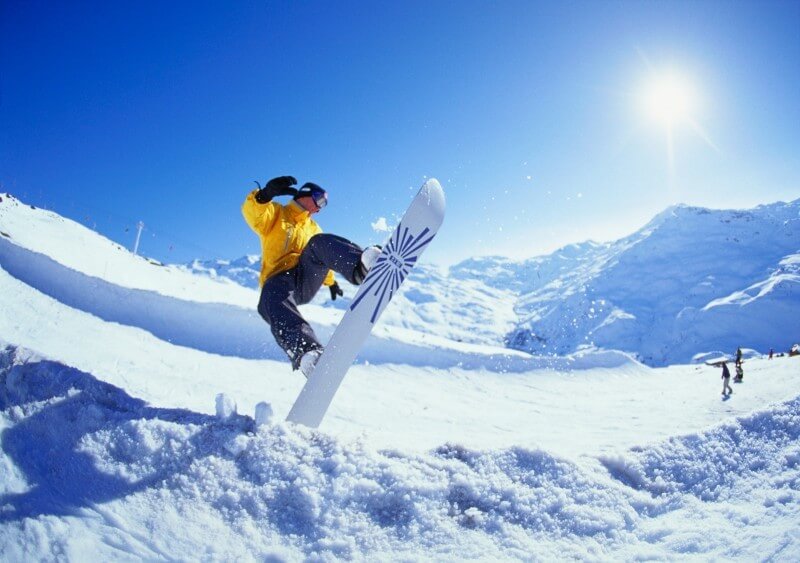Snowboarding evolved in the 1960s and 70s and only became popular in the 1980s. It would later develop to become an Olympic sport in 1998.
According to snowboarding enthusiasts, the sport that combines the adventure of competition, the allure of nature, and space for self-expression is therapeutic.
Snowboarding History
There are no comprehensive details in snowboarding history to show exactly where the winter sport originated. However, some reports indicate that it emanated from the US.
The prototype of modern snowboard started in 1965 when Muskegon, Michigan Engineer, Sherman Poppen, who also known as the father of snowboard designed the model that ushered in the modern ball.
His wife named the model Snurfer by combining surfing and snow, the purpose for which the model had been created.
The inaugural model comprised of two bolted skis.
Later, Poppen attached a rope at the front which would be used for steering. Users weren’t going to need any specialized bindings or boots to use the snurfer.
Snurfer’s Popularity
The popularity of the toy that Poppen had developed for his daughter would spread fast beyond his expectations.
This is how Brunswick Corporation, a sports equipment manufacturer discovered, licensed and started producing and distributing it across the country.
The snurfer was received well with approximately 70 million pieces sold by the end of the 1970s. This brought about the concept of gliding sideways on snow to new developers who picked the idea and enhanced it.
What makes Snowboarding Different?
While there are many winter sports, snowboarding and skiing are the most popular. Here are some differences between the two.
- The main difference between snowboarding and skiing is the equipment used. While skiers use two boards, snowboarders use a single wide board. In skiing, two skis are harnessed with bindings.
- While both snowboarders and skiers are attached to their boards with bindings, there are some variations.
For instance, snowboarder’s bindings are placed side by side leaving his feet to face sideways.
A skier, on the other hand, binds on the board at its length leaving the feet to face straight.
In case of an emergency, a snowboarder will have a hard time separating themselves from the board. Skiers, on the other hand, can do so with ease.
- Skiers utilize the skies to navigate and thrust themselves on the snow. Snowboarders, on the other hand, leverage their bodies to navigate and thrust themselves on the snow.
- There are notable differences when it comes to the terrain as well. For instance, the skiing terrain is diverse as compared to snowboarding.
What’s more, skiers can control their movement better since they have two skies to balance. This way, the skiers can navigate through forested areas which snowboarders can’t.
- Often, snowboarders sit and apply energy whilst on the edges. Skiers, on the other hand, can maintain an upright position when they are not skiing.
- Learning how to snowboard can be an arduous task both to beginners and seasoned skiers. When snowboarding was invented, skiing was already a popular winter sport.
- Snowboarding is easier on the knees as opposed to skiing. Further, snowboarders are unlikely to get knee injuries. However, snowboarders may have it rough on the wrists. Skiing is better executed on ice and bumps while snowboards are better executed in crud and powder.
Popular Ski Resort in Switzerland
Are you wondering where to go snowboarding in Switzerland? Verbier, the main resort of the 4 Vallées ski area is the largest ski region in Switzerland.
There are numerous ski cams in Verbier and Les Elfes is among the best. From the onset of December to the end of April, guests can enjoy winter camp lessons each week.
These sessions are specially designed for children and teenagers between the ages of 6 to 17 years.
Les Elfes strives to combine off snow learning and outdoor experience by offering diverse excursions and language courses.
The team of experienced professionals at Les Elfes is committed to maximize student’s experience on the mountain and enhance their skills.
Students also get a chance to interact with other students from diverse cultures and make new friends. To encourage students to perform better, a prize-giving ceremony is held after each trip.
Snowboarding Learner Levels
Every snowboarding student goes through various levels before finally mastering the sport.
At the end of level one, for instance, the snowboarder should be able to stop and show their ability to slide using varying amounts of edge depending on their speed.
Learners at level two should be able to confidently execute basic turns on a blue slope with the toe and heel edge albeit independently.
They should be in a position to turn from one edge to the other. At the fifth and final level, snowboarders should be able to slide through Red Pistes.
Further, they can use a piste map effectively and have acquired sufficient experience in itinerary route riding.
Fun and Interesting Facts about Snowboarding
Compared to other winter sports, snowboarding hasn’t been in existence for a long time. Still, it has played a critical role in the sports world. Here are some fun and interesting snowboarding facts that you should know.
1. Snowboarding was Initially Referred to as Snurfing
Sherman Poppen, Muskegon, Michigan, the engineer first invented snowboarding in the 1960s. He belted skis together and leveraged on a rope to steer the temporary board.
His wife would later combine the words snurfing and snow to come up with snurfing.
Following the snurfer’s popularity, companies knew there was potential in the new sport. The name was later changed.
2. Snowboarding Companies Thrive in Producing Viral Videos
Research indicates that promotional videos have played a huge role in promoting innovation in snowboarding tricks and gear.
In the past, such videos were circulated through VHS tapes.
Today, technological innovations have elevated the quality of these videos with companies producing and circulating them digitally.
Some sponsors today collaborate with athletes to produce promotional videos demonstrating the latest tricks and gear in the snowboarding collection.
Promo videos are ideal when it comes to selling new gear and encouraging athletes to try new tricks. The videos were critical in developing snowboarding support at the grassroots when the sport was less popular.
Snowboarding companies had mastered the art of creating viral videos before YouTube came into existence.
3. Snowboarding was outlawed in Resorts in the 1980s
Snowboarding may have evolved tremendously since it was first invented. However, did you know that this winter sport was once banned in resorts?
Due to its nature, snowboarding attracted many youths which made it appear like a teen craze as opposed to an Olympic sport.
This saw many resorts outlaw the sport in a bid to deter teenagers from proceeding to the slopes.
It was not until later when resorts started approving snowboarding, and this propelled them to instant popularity. This has remained the case to date.
4. Compared to Skiing, Snowboarding is more dangerous
Both skiing and snowboarding require lots of strength and balance. However, snowboarding is riskier as opposed to skiing.
During the sport, snowboarders utilize their bodies differently than skiers.
Snowboarders, especially beginners are likely to suffer injuries in the ankles, shoulders, and wrists.
5. The National Snowboarding Championship has been Prevailing for the last 33 Years
Some snurfing competitions were held in the 1970s. However, various snowboarding competitions were introduced in the 1980s.
Paul Graves who had previously supported Jake Burton in using his private board in snurfing competitions coordinated the inaugural National snowboarding championship in 1982.
Today, the competition is popularly known as the Burton US Open of Snowboarding. It has also been prevailing for the longest time.
In 1983, Tom Sims organized the World Championship Halfpipe Competition which was held in California.
The first Snowboarding World Cup would later be held in 1985 in Zurs, Austria.
6. The Inaugural Snowboarding Olympic Medal Nearly went up in Smoke
Canadian Ross Rebagliati won the inaugural snowboarding Olympic gold medal.
However, he was temporarily disqualified after blood tests returned positive results for marijuana.
The disqualification was later overturned.
To celebrate his victory, Ross smoked a joint and went on to become a medical marijuana crusader. Today, Ross runs his medicinal marijuana dispensary.
7. More than 10 Snowboarding Styles have emerged in the last 40 Years
There are numerous snowboarding styles.
Following the winter sport’s evolution that has been witnessed in the last 40 years, more styles will make it to the market.
Some of the popular styles include boardercross racing, freestyle snowboarding, and half pipe.
Snowboarding styles differ depending on various factors such as the terrain. For instance, freestyle snowboarding includes executing tricks on a snowboard while boarder cross comprises of racing over a bumpy course.
In big air competitions, snowboarders speed down a jump after which they execute tricks.
Other snowboarding styles include alpine snowboarding, jibbing, backcountry snowboarding, rail jam, slopestyle, freeriding, and cruising.
Snowboarders exemplify their personality through their snowboarding style and preferred board.
Finally
Snowboarding has evolved over the years with the emergence of diverse snowboarding styles. These facts help us understand snowboarding history better. As we’ve seen, mastering snowboarding can be an arduous task. You need to be consistent with your training and practice to finally understand the tricks.





